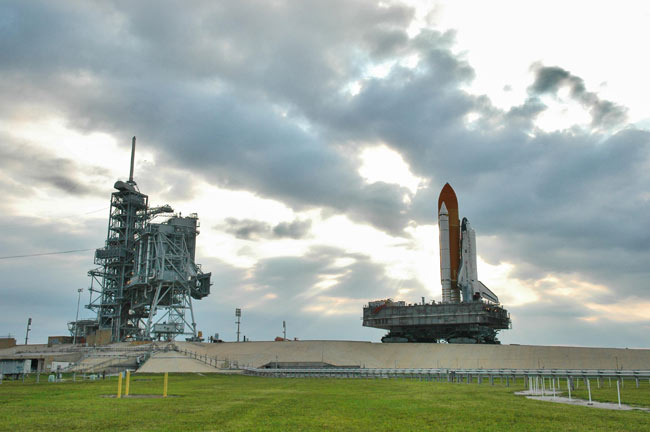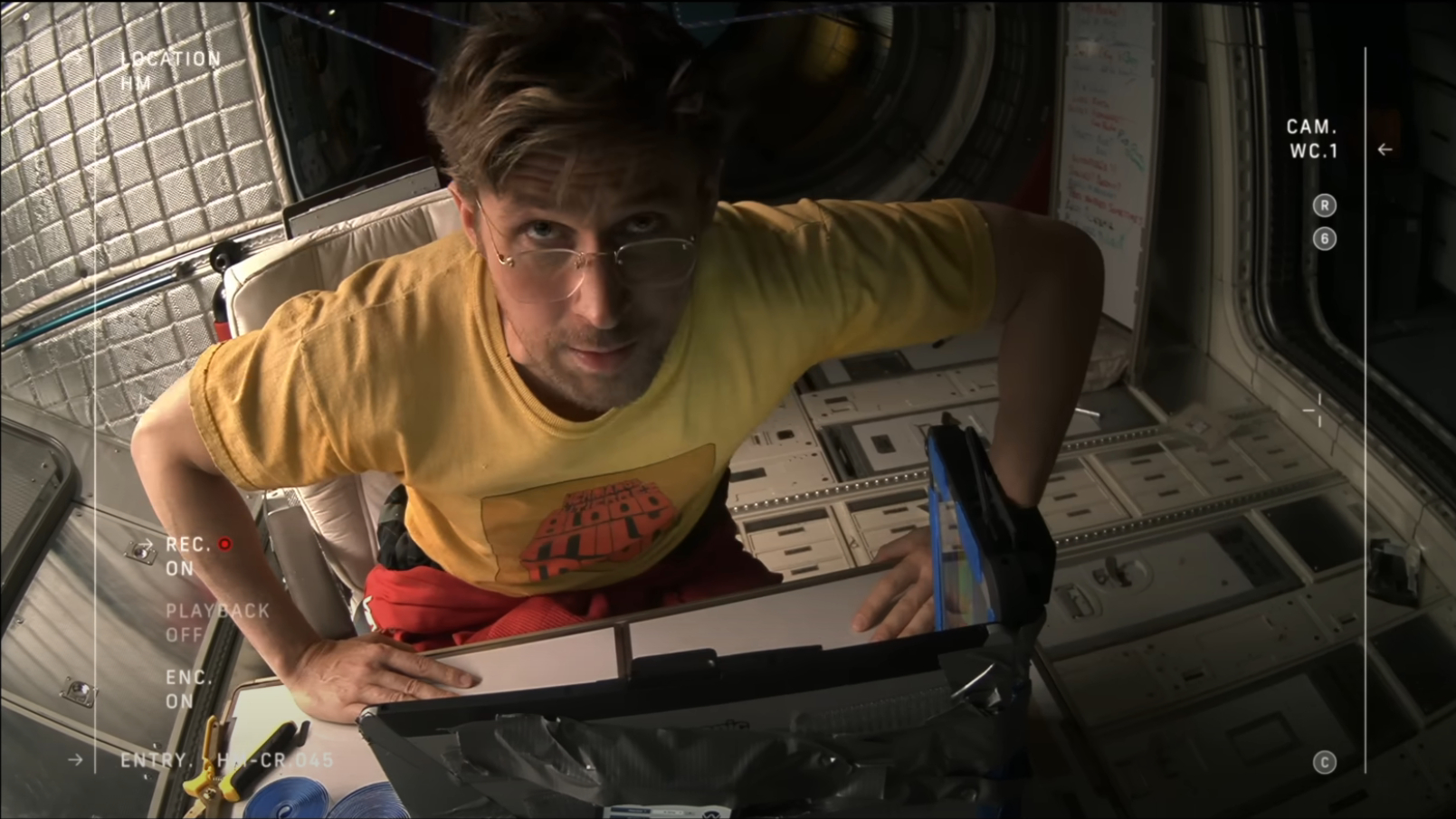Wide Load: Hauling Discovery One Crawl at a Time

As one teamof shuttle engineers works to pry NASA's Discovery orbiter from its externaltank, another is patiently waiting to fulfill its role as spaceship movers.
Shuttletransport workers rely on a series of specialized vehicles to move orbiters andsupport hardware from place to place and ultimately to the launch pad at NASA'sKennedy Space Center in Cape Canaveral, Florida.
"Weactually have three systems that maintain and operate, the biggest and mostnotable is the Crawler/Transporter and its [Mobile Launch Platform]," said RayTrapp, crawler/transporter manager for shuttle contractor United SpaceAlliance, in a telephone interview. "It's not something that you'd jump in andturn the key and it starts."
Only nineengineers are certified to drive the massive, six-million-pound (2.7-million-kilogram)crawler, which typically takes up to a year of training to operate. Morepersonnel, however, are qualified to handle a pair of vehicles that carryshuttle solid rocket booster motors to NASA's Vehicle Assembly Building (VAB),as well as another carrier reserved solely for delivering orbiters from theirprocessing facilities to the VAB.
It is thatlast vehicle, the Orbiter Transporter System, to which engineers expect to loadDiscovery atop this week after shuttle workers remove it from its external tank,USA officials said. The orbiter will be moved to a separate bay inside the VAB andfitted to a new external tank on June 7, before the entire assembly will againboard a launch pad-bound crawler, they added.
"You've gota $3 billion spaceship that you're carrying, so you have more of a feeling ofresponsibility," said Trapp, himself a crawler driver, of hauling Discovery tothe pad. "And these guys have a lot of pride in what we do."
NASA'sDiscovery spacecraft is currently scheduled to launch no earlier than July 13under the agency's STS-114 mission, its first shuttle flight since the 2003Columbia disaster that killed seven astronauts and destroyed their orbiterduring reentry.
Breaking space news, the latest updates on rocket launches, skywatching events and more!
Theexternal tank swapcurrently underway is designed to maximize launch safety for Discovery'sseven-astronaut crew. The new tank, ET-121, is being outfitted with anadditional heaterto minimize icedebris that could strike Discovery during launch.
Crawlingtoward launch
Dating backto the Apollo-era, the shuttle's crawler carriers and mobile launch platformwere originally built to move the colossal Saturn 5 moon rockets to the launchpad.
Neither ofthe transport systems was adapted to suite the space shuttle fleet, though severalupgrades were performed before the first orbiter flight, Trapp said.
"It's notas complex as a spaceship, but there're a lot of things going on in there," hesaid of the crawler. "One of the things we're very aware of is that the guys inthe 1960's who designed the crawler did a fantastic job."
Standing upto 26 feet (eight meters) high at its tallest, NASA's two crawler vehicles areeach 113 feet (34 meters) wide and 131 feet (40 meters) long. They carry acomplement 25 engineers and technicians under full operations and weigh up to18 million pounds when capped with a shuttle launch stack and launch platform. Alaser-guided docking system allows drivers position the massive load accuratelywithin a quarter of an inch at the launch pad.
"[That's]one of the things that's always amazed me," Trapp said.
While itsone mile an hour speed may seem slow for some, it's fast enough for Discovery.
"When you'rewalking on the ground, of course, at one mile an hour you can outwalk thecrawler in a heartbeat," said Bob Meyers, a systems engineer who droveDiscovery out of the VAB during its initial STS-114 rollout earlier this year, ina NASA interview. "But when you have 18 million pounds and you're up in the caband it's moving a mile an hour, it seems fairly fast."
Last week, thecrawler revisited Discovery at Pad 39B and returnedit to the VAB for the external tank swap.
WhileDiscovery's rollout and rollback have given crawler operators extra practice atreal-time driving, shuttle transports are often driven unloaded to keep them inworking order. All three transport systems are required to keep NASA's orbiterfleet flight ready, USA officials said.
"A lot ofthis equipment doesn't like to jut sit around," Trapp said. "So about every twoweeks or so, we'll run the OTS or the crawler just to check them out."
Notbigger, but better
Crawlerengineers have used the two years since the Feb. 1, 2003 loss of the Columbia andits crew to upgrade NASA's two crawlers with better electronics, ventilationand control cabs.
All four drivercabs - two per crawler - were replaced with newer versions equipped with safermarine windows to withstand Florida's hurricane season, which began this month.
"In thepast, we had to bolt plywood over the windows during hurricanes," Trapp said,adding that the new crawler cabs weather the multiple hurricanes that stuckFlorida in 2004 just fine.
Ventilationimprovements cleared exhaust from being sucked back into engine and pumpcompartments, providing a safer, more comfortable environment for engineers andtechnicians. Adjustments to the exhaust system also softened the crawler'snoise levels, and both vehicles received a new set of treads earlier this year.
"We haveanother big modification coming at the end of this year to the JEL hydraulicssystems," Trapp said.
Eachcrawler carries 16 Jacking, Equalization and Leveling (JEL) bearings to keepthe mobile launch platform and shuttle stack level during five percent inclineup to the launch pad.
"We'vespent a lot of man-hours upgrading and maintaining our equipment with the goalof making that first rollout since Columbia," Trapp said. "It feels reallygood, and when the time is right we'll launch."
- Fixing NASA: Complete Coverage of Space Shuttle Return to Flight
Join our Space Forums to keep talking space on the latest missions, night sky and more! And if you have a news tip, correction or comment, let us know at: community@space.com.

Tariq is the Editor-in-Chief of Space.com and joined the team in 2001, first as an intern and staff writer, and later as an editor. He covers human spaceflight, exploration and space science, as well as skywatching and entertainment. He became Space.com's Managing Editor in 2009 and Editor-in-Chief in 2019. Before joining Space.com, Tariq was a staff reporter for The Los Angeles Times covering education and city beats in La Habra, Fullerton and Huntington Beach. In October 2022, Tariq received the Harry Kolcum Award for excellence in space reporting from the National Space Club Florida Committee. He is also an Eagle Scout (yes, he has the Space Exploration merit badge) and went to Space Camp four times as a kid and a fifth time as an adult. He has journalism degrees from the University of Southern California and New York University. You can find Tariq at Space.com and as the co-host to the This Week In Space podcast with space historian Rod Pyle on the TWiT network. To see his latest project, you can follow Tariq on Twitter @tariqjmalik.
